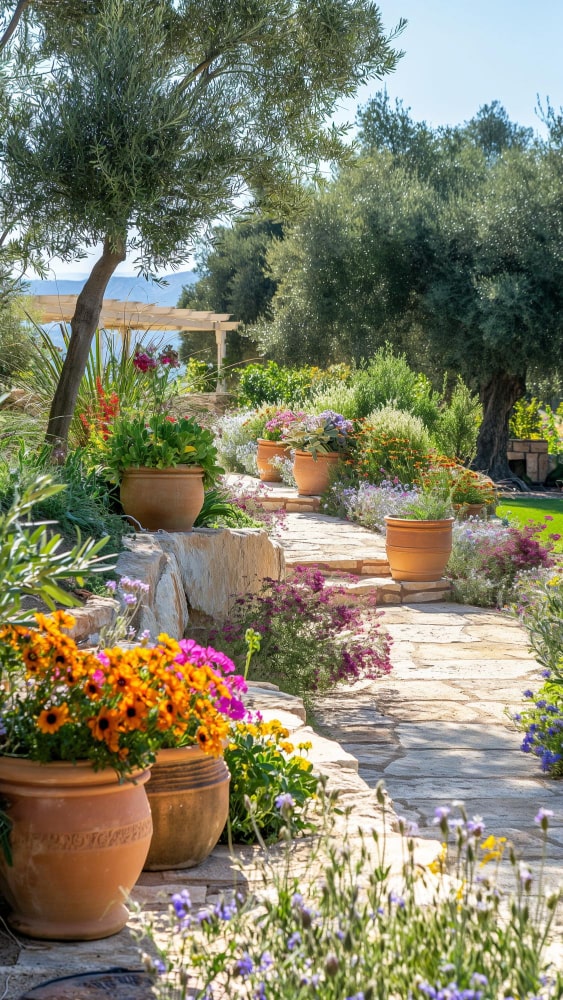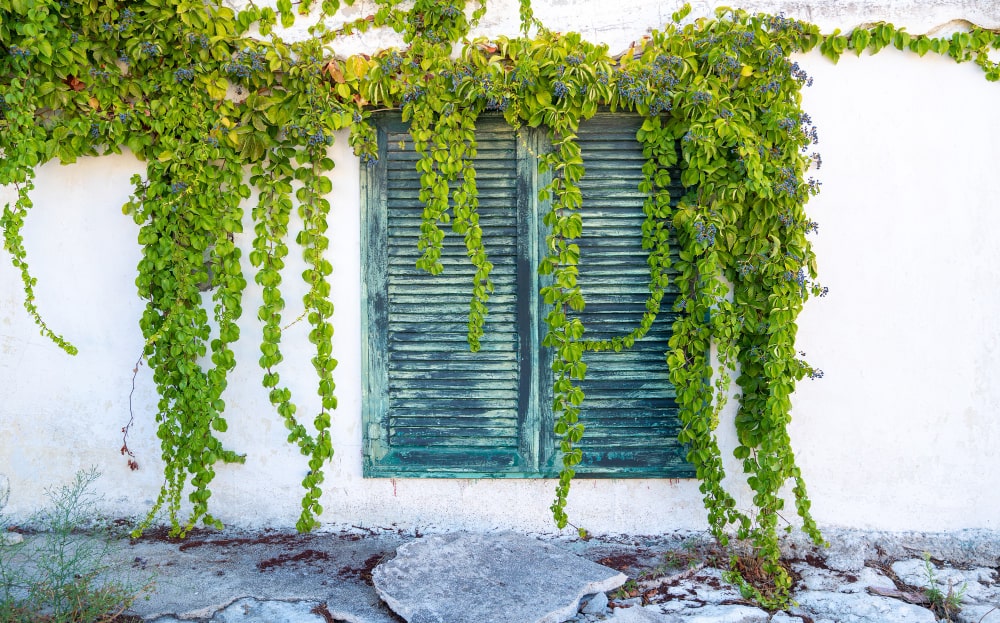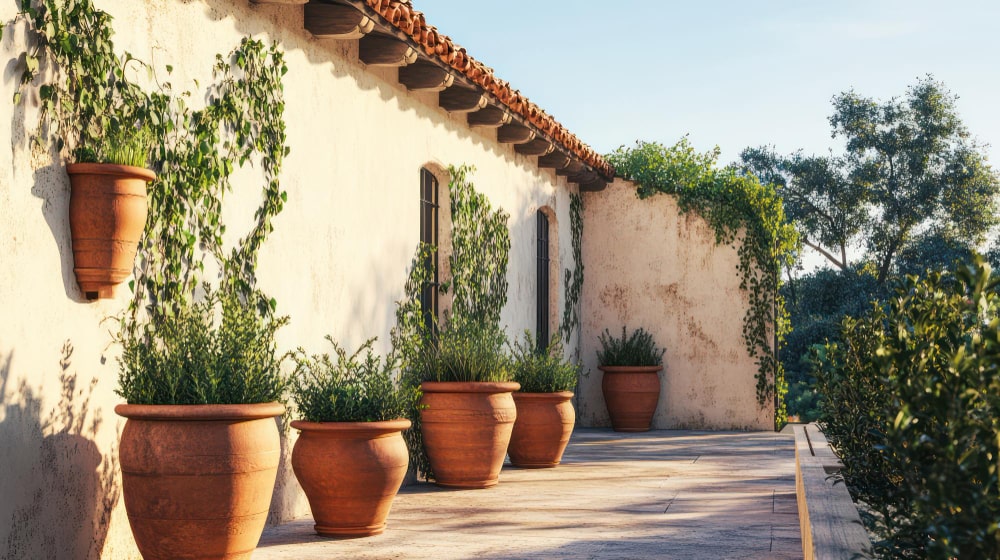The Mediterranean garden is much more than an exterior design trend; it is a way to connect with nature and make the most of the climatic features of the Mediterranean region.
This particular gardening style not only reflects the beauty of Mediterranean landscapes but also offers practical and sustainable solutions for those seeking a garden that adapts to the environment and requires less maintenance.
Below, we explain how a Mediterranean garden is composed and the key elements to create one in your home.
Why Do We Prefer the Mediterranean Garden?
The Mediterranean garden stands out for its ability to harmoniously integrate with the natural surroundings. One of the main attractions of this style is its adaptation to the climate and terrain, making it a practical and sustainable option.
The plants and materials used in the Mediterranean garden are designed to thrive in heat and drought conditions, thus minimizing water consumption and maintenance requirements.
Additionally, a Mediterranean garden provides a unique aesthetic that evokes the serenity and charm of Mediterranean coastal landscapes.
This gardening style is based on principles of functionality and beauty, combining native vegetation with traditional materials to create a space that is both visually appealing and ecologically efficient.
Elements of the Mediterranean Style

To start, designing an authentic Mediterranean garden involves considering several key elements that characterize this style. Here are the essential components you should keep in mind:
Ornamental Trees
Ornamental trees are a crucial part of any Mediterranean garden. These trees not only provide shade and structure but also add a touch of elegance and personality. Some of the most popular include:
- Olive Tree: This tree is emblematic of the Mediterranean landscape and is known for its longevity and resilience. Its silver foliage and edible fruits add an element of beauty and functionality.
- Willow: With its drooping branches and fluid appearance, the willow adds a romantic and relaxing touch to the garden.
- Purple Jacaranda: With its stunning purple blossoms, the jacaranda adds vibrant color and a delicate fragrance to the surroundings.
- Schinus Molle: Known as the false pepper tree, it offers dense foliage and an interesting texture.
Fruit Trees for the Mediterranean Garden
Incorporating fruit trees into your Mediterranean garden not only beautifies the space but also allows you to enjoy fresh and delicious fruits. Some of the most recommended include:
- Lemon Tree: Lemons add a fresh aroma and are perfect for making lemonade or adding flavor to your dishes.
- Orange Tree: Ideal for providing shade and juicy fruits that you can harvest and enjoy.
- Fig Tree: Fig trees are known for their lushness and ability to provide shade on hot days.
Herbaceous Beds
Herbaceous plants are an excellent addition to a Mediterranean garden, as they offer pleasant aromas and are useful in the kitchen. Some of the most popular are:
- Lavender: With its relaxing fragrance and purple flowers, lavender is perfect for creating a tranquil atmosphere.
- Rosemary: Ideal for cooking and as an ornamental plant, rosemary adds a touch of freshness to the garden.
- Sage: With its fragrant leaves and colorful flowers, sage is a versatile option.
- Thyme: Known for its resilience and culinary uses, thyme is an ideal complement for your garden.
- Oregano: Perfect for seasoning your dishes and adding a touch of green to your beds.
Fun Climbing Plants for the Mediterranean Garden
Climbing plants are ideal for adding color and vertical life to your Mediterranean garden. Some of the standout options are:
- Honeysuckle: With its fragrant flowers and rapid growth, honeysuckle is perfect for covering pergolas or trellises.
- Bougainvillea: With its vibrant flowers in shades of purple, pink, or red, bougainvillea adds a touch of color and exoticism.
- Japanese Jasmine: Although its name suggests a distant origin, Japanese jasmine adapts perfectly to the Mediterranean climate and offers a charming fragrance.

Paths and Walkways
The choice of materials for paths and walkways in a Mediterranean garden is crucial for maintaining the authenticity of the style. Typical materials include:
- Gravel: Gravel is economical and allows for adequate drainage, ideal for high-traffic areas.
- Marble Chips: These offer an elegant and durable appearance.
- Irregular Stone Slabs: Alcover stones or slate slabs provide a natural and rustic look, typical of the Mediterranean style.
Clay Pots and Jars for the Mediterranean Garden
Finally, clay pots and jars are traditional elements in the Mediterranean garden. These pieces have several advantages:
- Aesthetic Charm: Clay has a visual appeal that evokes the tradition and history of the Mediterranean area.
- Preservation of Freshness: Clay maintains a more stable temperature for the roots and helps conserve moisture, reducing the need for frequent watering.
How to Integrate These Elements into Your Garden
When designing a Mediterranean garden, it is important to integrate all these elements cohesively. Here are some recommendations to achieve this:
- Space Planning: Before starting, create a garden plan and decide where to place each element. Consider the location of trees and plants based on sun exposure and available space.
- Material Selection: Choose materials that are consistent with the Mediterranean style and complement the vegetation. Ensure that paths and beds are functional and aesthetically pleasing.
- Plant Combination: Mix ornamental trees, fruit trees, herbaceous plants, and climbing plants to create a vibrant and diverse space. Ensure that the chosen plants are compatible with each other and suitable for the climate.
- Sustainable Maintenance: The Mediterranean garden is known for its low maintenance. Take advantage of this by maintaining an efficient watering regimen and caring for plants with sustainable practices.
- Decorative Details: Incorporate traditional decorative elements, such as clay pots and ceramic objects, to enhance the Mediterranean character of the garden.
In summary, the Mediterranean garden offers a unique opportunity to create a space of natural beauty and functionality, adapted to local climatic conditions and lifestyle.
With the right elements and thoughtful planning, you can create a Mediterranean garden that is both beautiful and practical..
